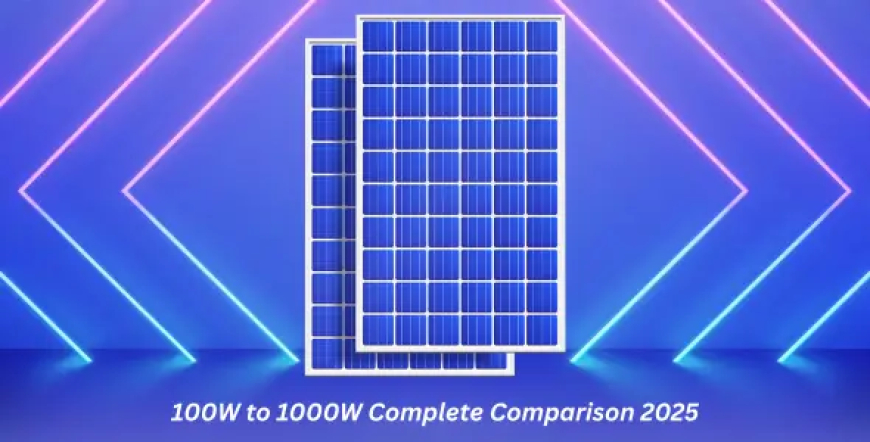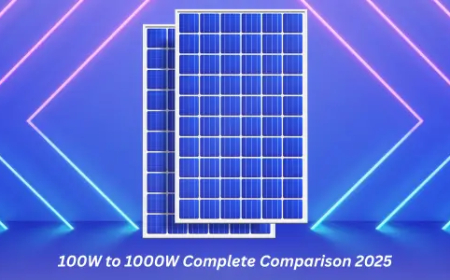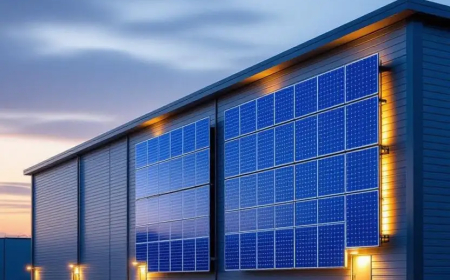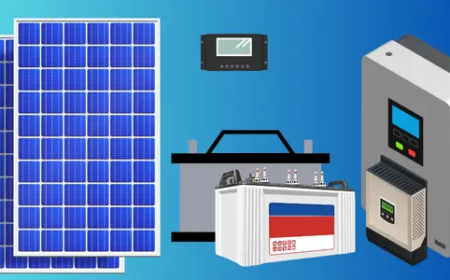Solar Panel Wattage Guide: 100W to 1000W Complete Comparison 2025
Complete guide to solar panels from 100 watt to 1000 watt. Compare sizes, prices, efficiency, applications, and top brands. Find the perfect solar panel wattage for your needs with expert recommendations.

Choosing the right solar panel wattage is crucial for powering your home, RV, boat, or off-grid system effectively. Whether you need a compact 100 watt solar panel for camping or a powerful 1000 watt panel for residential use, understanding the differences in power output, size, cost, and applications will help you make an informed decision. This comprehensive guide compares solar panels from 100W to 1000W, helping you select the perfect solution for your energy needs.
Understanding Solar Panel Wattage
Solar panel wattage indicates the maximum power a panel can produce under ideal conditions (Standard Test Conditions). A 200 watt solar panel, for example, generates 200 watts of electricity per hour at peak sunlight. However, real-world output varies based on sunlight intensity, temperature, panel angle, and shading.
The wattage you need depends on your daily energy consumption, available installation space, and budget. Smaller panels like 100W and 200W models suit portable and light-duty applications, while 300W to 1000W panels are designed for residential, commercial, and high-power off-grid systems.
100 Watt Solar Panel: Perfect for Portable Power
Specifications and Dimensions
A typical 100W solar panel measures approximately 42 x 20 inches (1030 x 460mm) for portable models, though rigid residential versions may be slightly larger. These compact panels weigh between 15-20 pounds, making them ideal for mobile applications.
Power Output and Applications
A 100 watt solar panel produces 400-500 watt-hours (0.4-0.5 kWh) of electricity daily under optimal conditions with 4-5 hours of peak sunlight. This is sufficient to power:
- LED lights and phone chargers
- Laptops and tablets
- Small fans and camping equipment
- 12V battery charging for RVs and boats
- Portable refrigerators (intermittent use)
- Water pumps and small appliances
Price Range by Brand
Top 100W Solar Panel Models:
- Renogy 100W Monocrystalline: $109-139 | 21% efficiency | 25-year warranty
- Jackery SolarSaga 100W: $199-249 | Foldable design | Portable with kickstand
- BougeRV 100W: $89-119 | Budget-friendly | Good for beginners
- Goal Zero Boulder 100: $199-249 | Rugged construction | 10-year warranty
- EcoFlow 110W Portable: $169-199 | Foldable | Fast charging technology
- Newpowa 100W: $79-99 | Value option | Basic functionality
- Rich Solar 100W: $89-109 | Reliable performance | Good warranty support
Best For
The 100 watt solar panel is perfect for camping enthusiasts, van lifers, boat owners, and anyone needing portable backup power. It's an excellent entry point for those new to solar energy.
200 Watt Solar Panel: Versatile Mid-Range Power
Specifications and Dimensions
200W solar panels typically measure 58 x 26.5 inches (1480 x 680mm) and weigh 25-35 pounds. They're available in both rigid and flexible formats for different mounting needs.
Power Output and Applications
A 200w solar panel generates approximately 800-1000 watt-hours (0.8-1 kWh) daily, doubling the capacity of a 100W panel. This powers:
- Multiple devices simultaneously
- Small refrigerators continuously
- Larger RV electrical systems
- Power tool charging
- Small cabin or tiny home essentials
- Emergency backup systems
- Off-grid security systems
Price Range by Brand
Top 200W Solar Panel Models:
- Renogy 200W Monocrystalline: $219-279 | High efficiency | Robust design
- BougeRV Arch 200W Flexible: $269-299 | Flexible/bendable | Anti-scratch coating
- Bluetti PV200: $279-349 | Portable foldable | Adjustable kickstand
- ECO-WORTHY 200W: $189-239 | Budget-friendly | Complete kit available
- Rich Solar 200W: $199-249 | Reliable brand | Good value
- Newpowa 200W: $159-199 | Affordable option | Solid performance
- Goal Zero Boulder 200: $379-449 | Premium build | Weather resistant
Best For
The 200 watt solar panel offers the sweet spot for RV owners, weekend campers, small cabin setups, and backup power systems. It provides enough power for comfort without excessive cost or space requirements.
300 Watt Solar Panel: Residential-Ready Power
Specifications and Dimensions
300W panels are typically residential-grade, measuring approximately 65 x 39 inches (1650 x 990mm) or 53 x 45 inches (1350 x 1134mm) depending on the manufacturer. They weigh 35-45 pounds.
Power Output and Applications
A 300 watt solar panel produces 1.2-1.5 kWh daily, making it suitable for:
- Partial home energy offset
- Large RV and motorhome systems
- Greenhouse operations
- Workshop power supply
- Well pumps and irrigation
- Small business applications
- Off-grid cabin main power source
Price Range by Brand
Top 300W Solar Panel Models:
- Canadian Solar 300W: $189-239 | HiKu series | Excellent reliability
- JinkoSolar 300W: $179-229 | Tiger series | High efficiency
- Trina Solar 300W: $169-219 | Budget residential | Good performance
- LONGi 300W: $189-239 | Hi-MO series | Premium quality
- Renogy 300W: $249-299 | RV-focused | Easy installation
- Silfab Solar 300W: $219-269 | North American made | Superior warranty
- Mission Solar 300W: $229-279 | USA manufactured | Domestic content
Best For
The 300 watt solar panel suits homeowners beginning their solar journey, serious off-gridders, and commercial applications requiring reliable power generation with manageable panel size.
500 Watt Solar Panel: High-Output Residential
Specifications and Dimensions
500W panels are large-format residential panels measuring approximately 82 x 45 inches (2100 x 1140mm) and weighing 55-70 pounds. These require professional installation due to their size.
Power Output and Applications
A 500 watt solar panel generates 2-2.5 kWh daily, providing substantial power for:
- Residential solar arrays (fewer panels needed)
- Commercial installations
- Large off-grid systems
- Agricultural operations
- Electric vehicle charging
- High-power workshop equipment
- Multiple appliances simultaneously
Price Range by Brand
Top 500W Solar Panel Models:
- Canadian Solar 500W: $379-449 | HiKu7 series | Excellent warranty
- JinkoSolar 500W: $359-429 | Tiger Neo | N-type technology
- Trina Solar 500W: $349-419 | Vertex series | Cost-effective
- LONGi 500W: $369-439 | Hi-MO 6 | High efficiency
- JA Solar 500W: $339-409 | DeepBlue 4.0 | Reliable performance
- Qcells 500W: $389-459 | Q.PEAK DUO | German engineering
- SunGoldPower 500W: $329-399 | Value option | Complete support
Best For
The 500 watt solar panel is ideal for residential installations wanting to minimize roof space, commercial projects, and large off-grid systems requiring significant daily energy production.
1000 Watt Solar Panel System: Maximum Power
Understanding 1000W Systems
True 1000-watt single panels don't currently exist in mainstream residential markets. When referring to "1000 watt solar panels," this typically means a 1kW solar system comprised of multiple panels (for example, four 250W panels, three 330W panels, or two 500W panels).
Power Output and Applications
A 1000 watt solar panel system generates approximately 4-5 kWh daily, sufficient for:
- Small residential homes (partial to full coverage)
- Comprehensive off-grid cabin systems
- Commercial applications
- Agricultural operations with high power needs
- Large RV or boat electrical systems
- Backup power for essential circuits
- Workshop or garage power independence
Price Range for 1000W Systems
Complete 1kW Solar Panel Systems:
- ECO-WORTHY 1000W Kit: $899-1,199 | Complete with accessories | DIY friendly
- Renogy 1000W Kit: $1,299-1,599 | Premium components | Expandable design
- Rich Solar 1000W Kit: $999-1,399 | Value package | Good support
- WindyNation 1000W: $1,099-1,499 | Complete off-grid kit | Marine-grade
- HQST 1000W Kit: $849-1,199 | Budget option | Basic functionality
- Grape Solar 1000W: $1,199-1,599 | Residential quality | Grid-tie ready
Best For
The 1000 watt solar panel system suits small homes, comprehensive off-grid setups, backup power installations, and anyone serious about energy independence without full roof coverage.
Solar Panel Comparison Chart
| Wattage | Dimensions (approx.) | Weight | Daily Output | Typical Price | Best Applications |
|---|---|---|---|---|---|
| 100W | 42" x 20" | 15-20 lbs | 0.4-0.5 kWh | $79-$249 | Camping, portable, small devices |
| 200W | 58" x 26" | 25-35 lbs | 0.8-1 kWh | $159-$449 | RVs, boats, backup power |
| 300W | 65" x 39" | 35-45 lbs | 1.2-1.5 kWh | $169-$299 | Small homes, large RVs, cabins |
| 500W | 82" x 45" | 55-70 lbs | 2-2.5 kWh | $329-$459 | Residential, commercial, large systems |
| 1000W System | Multiple panels | Varies | 4-5 kWh | $849-$1,599 | Complete home systems, off-grid |
Key Factors When Choosing Solar Panel Wattage
Calculate Your Energy Needs
Review your electricity bills to determine daily kilowatt-hour consumption. For off-grid applications, list all devices and their power requirements. This calculation determines the total wattage needed.
Consider Available Space
Larger wattage panels require more installation area. A 100W panel needs approximately 6 square feet, while a 500W panel requires 25+ square feet. Measure your available roof or mounting space before selecting panel size.
Budget Considerations
Higher wattage panels offer better cost-per-watt value but require larger upfront investment. A 500W panel costs roughly $400, while achieving the same power with five 100W panels costs $500-700. However, smaller panels offer installation flexibility.
System Voltage Requirements
Match panel voltage to your battery bank and inverter specifications. 100-200W panels typically operate at 12V or 24V, while larger 300-500W panels are usually 24V or 48V systems.
Portability vs. Permanence
If you need portable power for camping or temporary setups, choose 100-200W panels with folding designs. For permanent installations, larger 300-500W panels provide better long-term value.
Future Expansion
Consider whether you might expand your system later. Many charge controllers and inverters support adding additional panels, making it easier to start small and grow your capacity over time.
Installation Considerations by Wattage
100W-200W Panels
These lightweight panels are DIY-friendly for most users. Basic tools, mounting brackets, and MC4 connectors are typically all you need. Ground mounting or temporary setups are straightforward.
300W-500W Panels
Larger panels benefit from professional installation, especially for roof mounting. Their size and weight make handling challenging for one person, and proper weatherproofing is critical for longevity.
1000W Systems
Complete 1kW systems should involve professional consultation for optimal design. Electrical code compliance, permit requirements, and safety considerations make expert guidance valuable.
Top Brands Across All Wattages
Premium Tier
- Maxeon (SunPower): Industry-leading efficiency and warranties
- Canadian Solar: Excellent balance of quality and value
- Qcells: German engineering, superior performance
- REC Solar: High efficiency HJT technology
Mid-Range Quality
- JinkoSolar: World's largest manufacturer, proven reliability
- LONGi Solar: High-output, competitive pricing
- Trina Solar: Dependable performance, value pricing
- Renogy: RV and off-grid specialist
Value Options
- ECO-WORTHY: Affordable complete kits, good support
- Rich Solar: Budget-friendly, reliable
- Newpowa: Entry-level pricing, basic functionality
- BougeRV: Portable options, flexible designs
Efficiency and Panel Type
Monocrystalline Panels
All major brands now use monocrystalline technology across all wattages, offering 19-24% efficiency. Higher efficiency means more power from less space, crucial for limited installation areas.
Polycrystalline Panels (Legacy)
Older technology with 15-18% efficiency, gradually being phased out. Mainly found in budget or clearance products. Generally not recommended for new installations.
Thin-Film and Flexible
Specialized applications like flexible 200W panels for curved RV roofs. Lower efficiency (13-16%) but unique form factors justify the tradeoff in specific scenarios.
Maintenance and Longevity
Expected Lifespan
Quality solar panels from reputable manufacturers last 25-30 years with minimal performance degradation:
- Years 1-10: 95-98% of rated output
- Years 11-20: 90-95% of rated output
- Years 21-30: 85-90% of rated output
Maintenance Requirements
All wattages require similar basic maintenance:
- Clean panels 2-4 times annually
- Check mounting hardware for tightness
- Inspect wiring connections for corrosion
- Monitor output through system controllers
- Trim nearby vegetation to prevent shading
Frequently Asked Questions
What size solar panel do I need to charge a 12V battery?
A 100W solar panel is typically sufficient for maintaining or slowly charging a 100Ah 12V battery. For faster charging, a 200W panel is recommended. Calculate based on your battery capacity and daily power consumption.
How many 100W panels equal a 500W panel?
Five 100W panels equal one 500W panel in total output. However, using one 500W panel typically costs less, requires fewer mounting points, and has one connection point versus five separate panels.
Can I mix different wattage panels in one system?
While technically possible with MPPT charge controllers, it's not recommended. Mixed wattages can reduce overall system efficiency. If mixing is necessary, ensure voltage specifications match and panels are on separate strings.
What's the best wattage for an RV?
Most RVs benefit from 200-400W of solar capacity. Weekend warriors manage with 200W, while full-time RVers typically need 400-800W. Calculate based on your appliances and camping style.
Do higher wattage panels produce more power in cloudy weather?
All panels lose efficiency in cloudy conditions proportionally to their rating. A 500W panel won't outperform a 100W panel per watt in clouds—both produce roughly 10-25% of rated output in overcast conditions.
How much roof space do I need for 1000W of solar?
A 1000W system requires approximately 60-70 square feet of unshaded roof space. This accommodates 3-4 panels with proper spacing for maintenance access and ventilation.
Are flexible solar panels as efficient as rigid panels?
Flexible panels typically achieve 15-18% efficiency versus 19-22% for rigid panels. However, their ability to conform to curved surfaces and lightweight construction make them ideal for specific applications like RVs and boats.
What wattage solar panel charges a laptop?
A 100W solar panel easily charges laptops (typically 45-90W power adapters). For reliable laptop charging in variable conditions, a 100W panel with a portable power station provides consistent power.
Making Your Final Decision
Selecting the right solar panel wattage depends on balancing your power needs, available space, budget, and application. Start by calculating your daily energy consumption, then choose the smallest panel configuration that meets those needs with a 20-30% buffer for inefficiencies and cloudy days.
For portable and recreational use, 100-200W panels offer maximum flexibility. For residential applications, 300-500W panels provide the best value and performance. For comprehensive systems, combining multiple panels in a 1000W or larger array delivers energy independence.
Research brands carefully, prioritizing warranty coverage, efficiency ratings, and customer support. Premium brands like Canadian Solar, JinkoSolar, and Qcells command higher prices but deliver superior long-term performance and reliability.
Consider starting with a smaller system and expanding as your needs grow. Modern solar equipment is designed for scalability, allowing you to add capacity without replacing existing components.
What's Your Reaction?
 Like
0
Like
0
 Dislike
0
Dislike
0
 Love
0
Love
0
 Funny
0
Funny
0
 Angry
0
Angry
0
 Sad
0
Sad
0
 Wow
0
Wow
0






